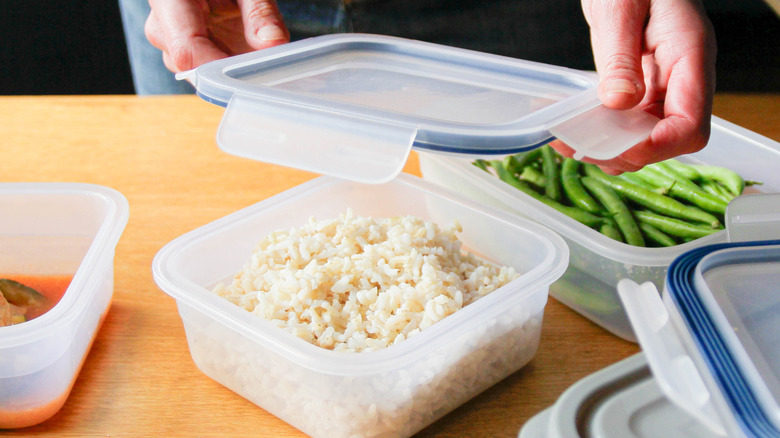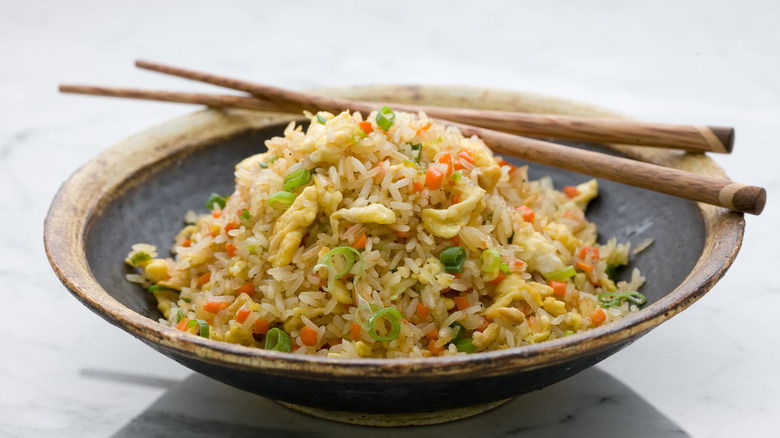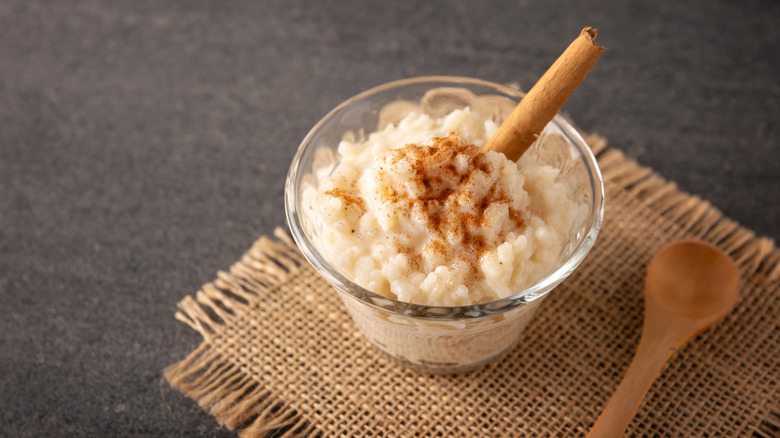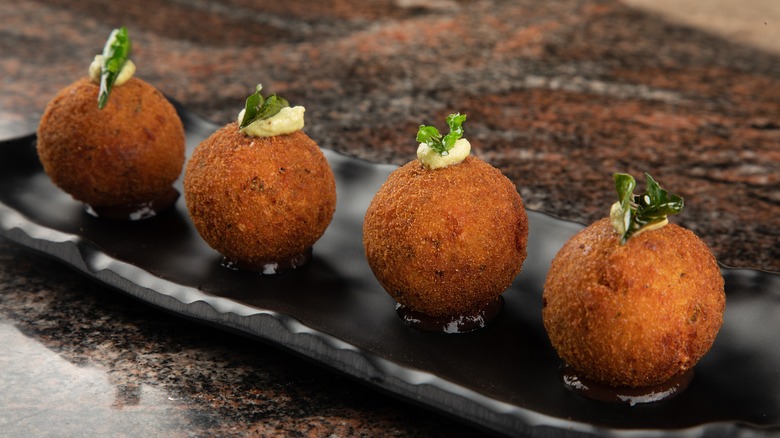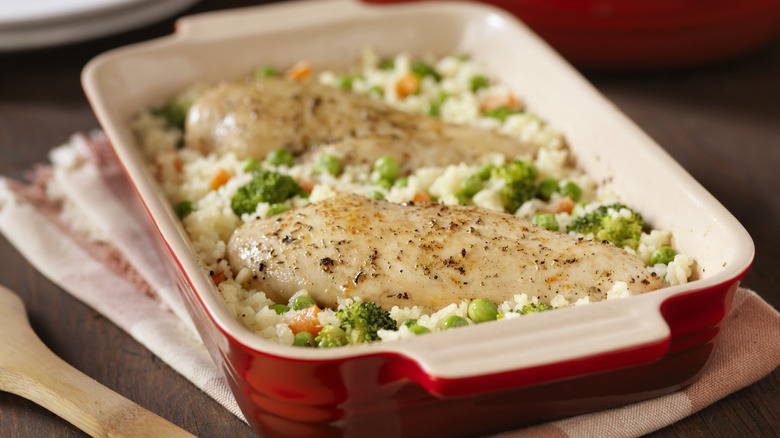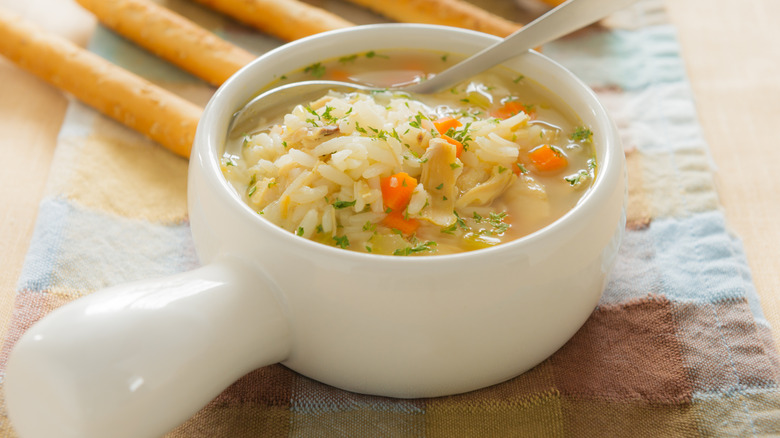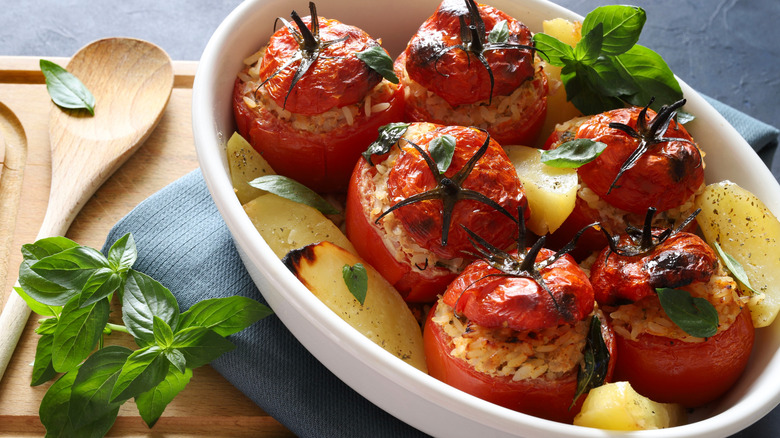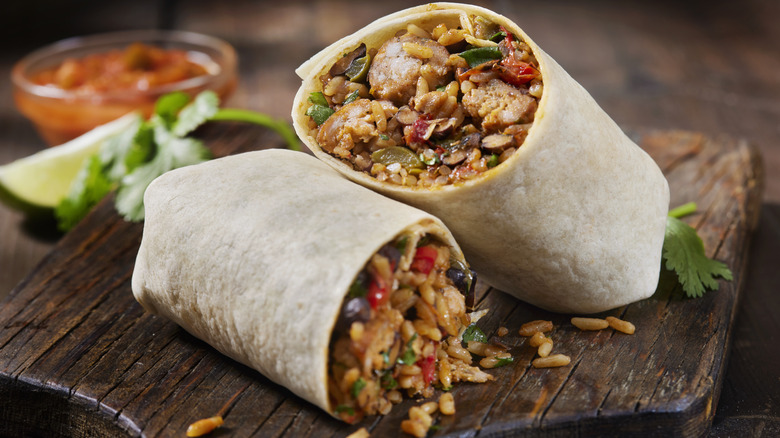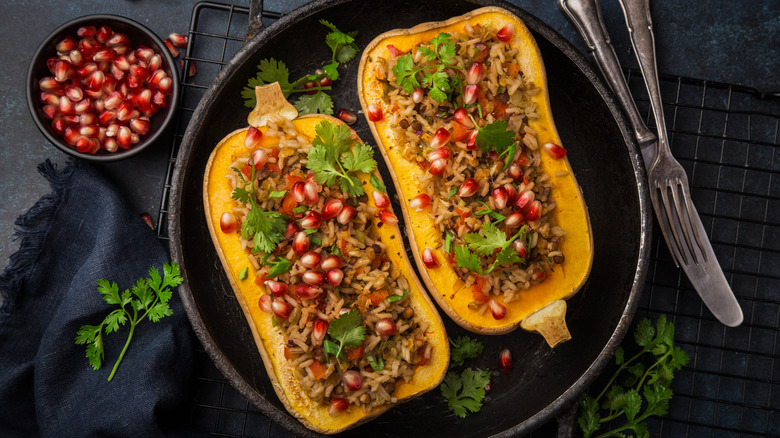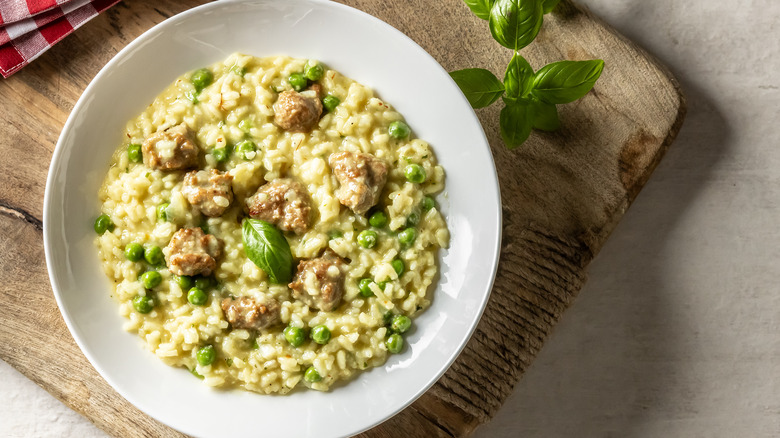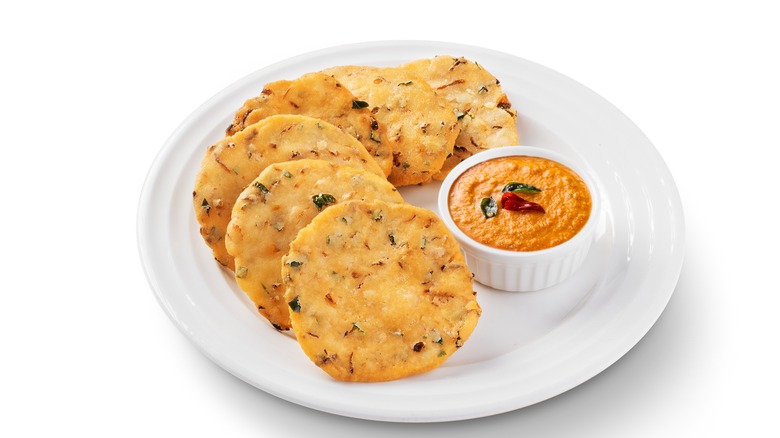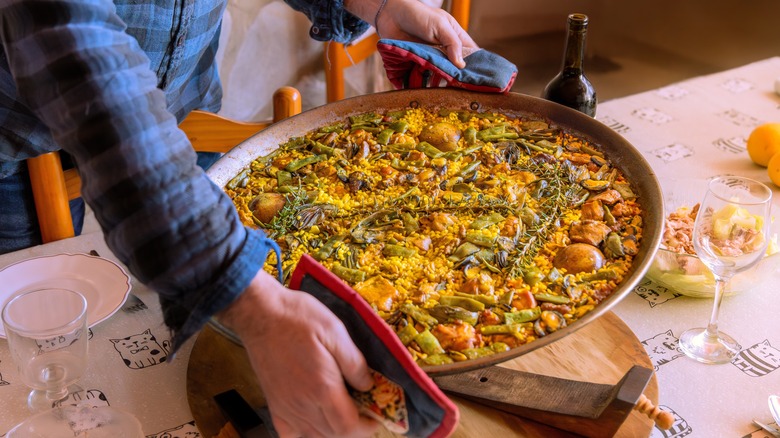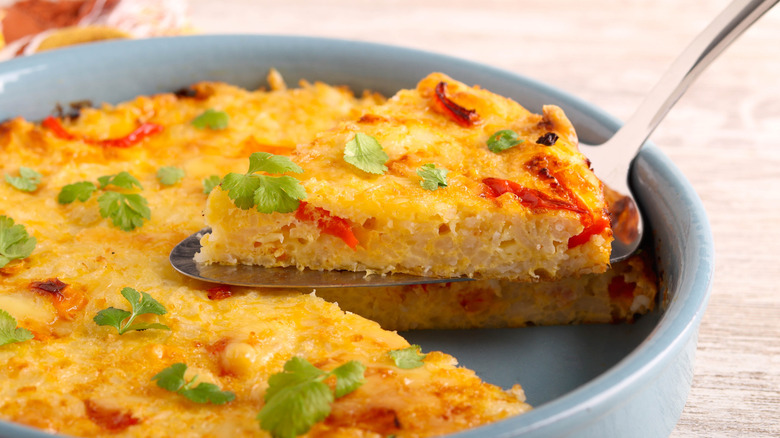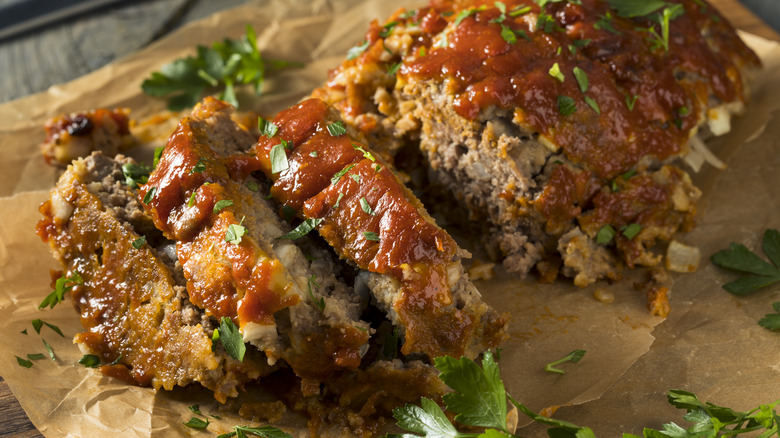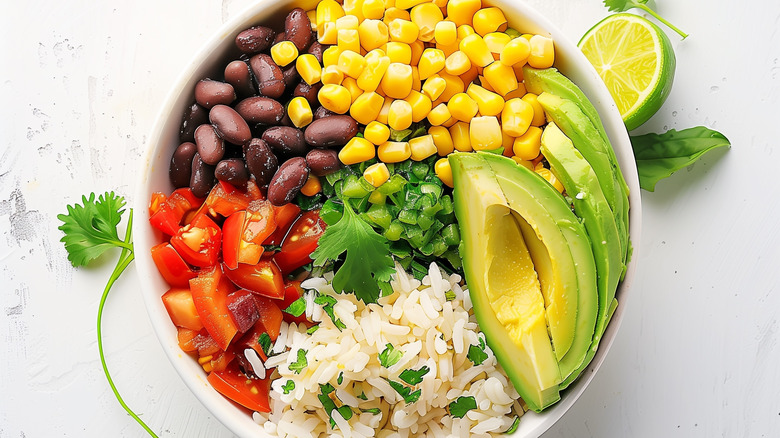16 Things You Can Make With Leftover Rice
Rice, like pasta, is one of those foods that we always seem to make in overabundance. When looking at a cup of uncooked rice, it never appears like nearly enough to feed yourself or your family, so you throw another cup of uncooked rice into the pot. And maybe another one. The rice cooks, doubles in size, and suddenly you have enough rice to feed an army. What are you going to do with all of those leftovers?
Luckily, leftover rice is incredibly versatile, and can be repurposed into some amazing next-day dishes. The key, though, is treating it the right way. Remember that leftover rice could give you food poisoning, so it's crucial to learn how to avoid this. The proper way to store and reheat leftover rice is to put it in an airtight container and place it in the fridge quickly — within two hours after the rice is finished cooking, at the very latest. Then, eat the leftover rice within three to four days, and when reheating it, make sure the rice reaches at least 165 degrees Fahrenheit. Got it? Good. Now, here are some of the best things you can make with your (safely stored) leftover rice.
Fried rice
The most obvious use for any leftover rice is fried rice, because most recipes for it — like one for some tasty SPAM-infused fried rice — calls for leftover fried rice that's been properly cooled anyway. Freshly cooked rice is too sticky for proper frying and achieving the right fried rice texture.
To make perfect fried rice, beyond using leftover rice, make sure that you're not over-applying your soy sauce. Just a few teaspoons will do. Additionally, try to buy a light soy sauce if you can find it. Then, add your egg to the oil first, rather than your rice, before folding the rice into the cooking eggs.
Don't think you'll have a hankering for fried rice within the next three to four days, when your refrigerated leftovers will be at their peak tastiness and safety? You can freeze leftover rice for quick fried rice whenever you want. It'll last for a few months in the freezer, though the quality will gradually deteriorate the longer it's stored.
Rice pudding
Turn your leftover rice into a comfort food dessert by preparing rice pudding. Don't worry if your cooking skills are limited — you don't need a recipe to make rice pudding with leftover rice. Make sure that the rice is reheated to the safe, recommended temperature of 165 degrees Fahrenheit, and from there, the process is all about achieving your desired flavor, as well as the creamy texture that rice pudding is known for.
For flavor, you'll just need some sort of sweetener, like sugar or honey, and potentially some spices, like cinnamon and nutmeg. For texture, you'll need milk. Combine the leftover rice with the milk in a saucepan — not too much; remember, you don't want it to be too thin — and bring it to a boil. Add more milk if the mixture becomes too gloopy, and then add in your sweetener and any other flavoring ingredients to taste. After ensuring that the rice is cooked to a safe temp, it's ready to serve. You can top rice pudding with any extras you might like, such as nuts or dried fruit.
Arancini
Need an appetizer that's easy to make and affordable, but that'll look fancy when you serve it to guests — so fancy that no one will ever guess that this dish all began with your takeout leftovers? Enter arancini. This Italian appetizer is basically just a deep-fried risotto ball, and while some recipes will encourage you to make the risotto for arancini from scratch, multiple culinary professionals use leftover rice for arancini, because it can be drier and easier to form than the freshly made version.
Do note, however, that while a traditional arancini recipe will instruct you to form your cooled risotto into balls for frying as-is, if you're using leftover rice for arancini, you'll need to add some binding ingredients — such as some eggs or breadcrumbs — to keep the rice together. Once your binder is added, you can form the rice balls (don't forget the cheese filling!), dredge them, and deep-fry them.
Stuffed peppers
Stuffed peppers are one of the many classic family dinners that deserve a comeback. They're hearty. They're filling. They're oh-so-versatile — in fact, they're so versatile that you can use leftover rice as your stuffed pepper filling. Just pull it from the fridge once your peppers are ready to be stuffed, and combine the rice with your other chosen ingredients, such as tomato sauce, ground beef, or cheese. Stuff your peppers and bake like normal.
Looking for a little variety? You've got options. Add zucchini, mushrooms, and onions to your filling for Princess Diana's favorite meal (no, really!). Give your stuffed peppers an Italian twist by using mozzarella cheese instead of cheddar, marinara instead of tomato sauce, and Italian sausage instead of ground beef. For Mexican flair, keep the cheddar and ground beef, but use salsa instead of tomato sauce, and throw in a packet of taco seasoning, too. Want a breakfast-inspired stuffed pepper? Use ground breakfast sausage, a variety of veggies, and top it all with a fried egg.
Casseroles
What is a casserole, really? There are some requirements beyond just being food cooked in casserole dish. Most casseroles feature a few basic ingredients: a protein, vegetables, sauce, cheese, and a starch — and rice makes the perfect starch to add to your next casserole.
If you don't think you're a fan of casseroles because you were forced to eat too many subpar versions of them as a child, it's time for you to rediscover all the ways casserole recipes are guaranteed to make your life easier, as well as more delicious. There are so many casseroles and so many recipes that can be made with affordable, household ingredients (including leftovers), in as much time as it takes to fill up your casserole dish and throw it in the oven. So, pair that leftover rice with chicken (or beef, or tuna, or turkey), and then pick your veggies of choice. Add in a sauce — cheese sauce, tomato sauce, sauce made from a can of your favorite condensed soup. Toss on some cheese and you're done.
Stuffed cabbage
Stuffed cabbage (aka cabbage rolls) require cooked rice, so if you have any left over, it's time to try this dish. A classic cabbage roll recipe will require you to stir together a filling of rice, ground meat, egg, and seasonings, before rolling this filling up within a cabbage leaf. Then, you'll bake the leaves in a tomato-based sauce. Depending on your individual recipe, the ground meat may differ, as will the sauce.
Prefer to use your slow cooker for this task? A slow cooker stuffed cabbage recipe will be much the same, except you'll let the stuffed rolls simmer in a slow cooker for several hours on a high heat setting. If you don't want to deal with the task of rolling the cabbage leaves, you can even make unstuffed cabbage rolls, by tossing all the normal ingredients in your slow cooker as is, with no rolling required.
Soup
Some of the best soups come about when you simply open up your fridge, take a gander at your leftovers and other ingredients you might have on hand, and then combine them all in one simmering pot of goodness. However, the key to using leftover rice in soup is to not re-cook the rice in the soup.
Instead, reheat your leftover rice separately. Don't throw it in the soup pot along with your broth, protein, veggies, or other desired ingredients. Only once your soup is ready to eat, spoon the piping-hot leftover rice into your serving bowls, followed by the actual soup. Stir and chow down. This ensures that the rice isn't overcooked, as it might be if you were to add it to a boiling or simmering broth for a lengthy amount of time. Use leftover rice in soups that normally call for rice, such as a chicken and lemon soup recipe, or use it in place of noodles in other soups.
Stuffed tomatoes
There's just something about stuffing rice into a vegetable that makes that vegetable all the more delicious. Maybe it's the mere fact that you're stuffing a starch — and usually some cheese — into the vegetable's cleared-away cavity. Maybe these simple dishes just feel especially homey. Whatever the case may be, beyond stuffing peppers with leftover rice, you can do the same with tomatoes — and just like how stuffed peppers are extremely versatile, so are stuffed tomatoes, so you can really get creative with the flavor profile.
For example, while some stuffed tomato recipes call for quinoa, you can swap the quinoa for rice, and pair it with feta cheese and seasonings for a quick, easy, healthful, and vegetarian meal. You can mimic the classic flavor profile of a stuffed pepper by combining your rice with ground beef and cheddar cheese. You can go Italian with sausage and mozzarella, or Mexican with ground beef, cheddar, and taco seasonings. As long as the flavors of your chosen ingredients work with tomatoes, it'll work with this recipe.
Burritos
Stop only eating burritos at your favorite Mexican fast-food chain. The process of preparing burritos is easy, quick, affordable, and convenient, so you really should be making them at home, just like you might make a sandwich. It's a great way to use up some leftover rice that is properly reheated.
While you're at it, consider moving beyond your basic beans, rice, and cheese burritos, and check out some of the many alternative burrito styles you need to try. Smother your burrito in a green or red sauce like an enchilada for a wet burrito. Have a flat-top grill or griddle at your disposal? After rolling your burrito, heat it up until it sports a golden-brown exterior for a crispy Dorado-style burrito. Go outside of your typical Mexican and Tex-Mex flavor pairings, and infuse your burrito with Korean or Japanese deliciousness. Leftover rice, kimchi, bulgogi, chicken katsu — roll it all up in a tortilla, and the result is worlds away from what you'd get at a local Taco Bell.
Stuffed squash
Stuffed squash requires a bit more time and a little more finesse than making stuffed peppers or stuffed tomatoes, but they can still be an equally rewarding way to eat your leftover rice. You can combine the rice with similar combos of ground protein, cheese, and sauce, but you'll need to take care to pick the right squash to stuff, as well as to match the flavor profiles of your chosen gourd. The many types of squash can be broken down into summer and winter squashes, and then those squashes are subdivided by their best uses, whether that's stuffing, roasting, or even pickling.
For example, you can stuff zucchini, acorn squash, and butternut squash, but you probably don't want to attempt stuffing curvy tromboncino squash. Looking for an impressive holiday side dish? Stuff acorn squashes with a mixture using leftover brown or wild rice, incorporating plenty of fall flavors like sage, apple, or pecan, and then serve an individual stuffed acorn squash to each guest at your table.
Risotto
Can you really make risotto with leftover rice? Yes! While it might sound strange — the whole point of risotto is to slowly simmer arborio rice in broth until it creates a thick, flavorful dish — you can use leftover rice to make what is, essentially, an imitation risotto. What you'll basically do is make a roux, add milk and broth to create a thick sauce, and then incorporate your leftover rice along with any desired seasonings, adding more liquid if needed to get a risotto-like consistency. Don't forget that when you add Parmesan, that will further thicken the "risotto."
If you want something that's a little more unique than your classic risotto flavored primarily with chicken broth and Parmesan, consider using leftover rice to make a version of Wisconsin risotto with smoked cheddar, beer, and bratwurst, made even more flavorful with caramelized onions. Serve this at your next football watch party or Oktoberfest get-together.
Rice fritters
Transform your leftover rice into flavorful fritters. Just like you might mix leftover rice with a few binding ingredients to deep-fry some rice balls and make arancini, you can mix rice fritters with similar binding ingredients to form patties for frying in a pan.
For example, mix leftover rice with seasonings, cheese, egg, and a little flour to make a straightforward and easy rice fritter. Trying to increase your veggie intake? You can also incorporate some vegetables into your rice fritter mix, such as grated zucchini or carrots. Flavor these basic fritters with spices and seasonings that complement the cuisine you're making. They work well with salads, as a side for fish or chicken, or just on their own.
When frying your rice fritters, just be careful not to flip them too early in the cooking process, or more than necessary, as you'll end up breaking the fritters into pieces — not exactly the result you want.
Paella
Like risotto, paella is one of those dishes that gets its characteristic flavor and texture from the way you cook the rice. So how can you use leftover rice to make a paella? The process is pretty similar to how you might use leftover rice to make fried rice. You'll cook your meat in a large pan, add your vegetables, as well as some stock and seasonings. Then, when you're almost done, you'll add the leftover rice and let it reheat thoroughly.
Remember, though, that there are plenty of variations on paella, so if you don't have the classic ingredients — such as chicken, bell peppers, and peas — you can get creative. Use varying types of beans or legumes, like lima beans or butter beans. Leave out the chicken, but add in some seafood, pork, or chorizo. Really, any meat and veggies that you have on hand can be used to make your own take on this Spanish dish.
Frittata
Frittata is a good choice for using up leftovers in general. At its heart, a frittata is a crustless quiche or an open omelet, so if an ingredient can be used in either of these dishes, it can be used in a frittata. The only real requirement is that your frittata's body be made out of eggs, which will hold all your other leftover ingredients in place.
You can incorporate leftover rice into your frittata in a few ways. You could begin crisping your leftover rice in a hot pan before pouring over your whisked eggs and other ingredients, and then popping it all in the oven for a frittata with a crisped rice base. You could also whisk the leftover rice into the egg mixture, so that the rice is more evenly distributed throughout the whole frittata. Whatever your choice may be, you can use any leftover rice that you happen to have on hand, including white, brown, and arborio.
Meatloaf
The great American meatloaf requires a binding agent, something to keep all that meaty goodness together in loaf form. Many home cooks will go for breadcrumbs, soaked bread, or crumbled crackers for this task — but if you have leftover rice on hand, consider using that instead. It can be considered among the underrated ingredients that will change the way you make meatloaf moving forward.
However, if you decide to use leftover cooked rice in your meatloaf and end up loving it, and then want to use the same process later when you don't have leftover rice on hand, do not attempt to add uncooked rice to your meatloaf instead. The loaf will not have enough moisture to properly cook the uncooked rice, and you'll be left with a crunchy loaf. Take the extra time necessary to cook rice before adding it to the raw meat after it has cooled. If you've already made this mistake, your lone option is to break the loaf apart and finish cooking it on the stovetop in a simmering liquid to soften the rice, creating a thick, meatloaf-flavored sauce that you can serve on, say, mashed potatoes.
Buddha bowls
Whether you call it a rice bowl, grain bowl, burrito bowl, or Buddha bowl, these (often) vegetarian meals usually include rice or another whole grain, as well as plant-based protein, lots of veggies, and a tasty sauce. Otherwise, Buddha bowls aren't really held to any strict standards. They're just meant to be simple and healthful — and what could be simpler than using up your leftovers?
Looking into the fridge and feeling unsure what you should place in your bowl alongside your leftover rice? For the healthiest and most balanced rice bowl possible, pair about a half cup of rice with 1 cup of vegetables, plus 2 or 3 ounces of protein, and a couple tablespoons of sauce. Not overdoing it on the toppings will ensure that you actually get to enjoy the various flavors you've combined, without overwhelming your taste buds with so many different foods in every bite.
